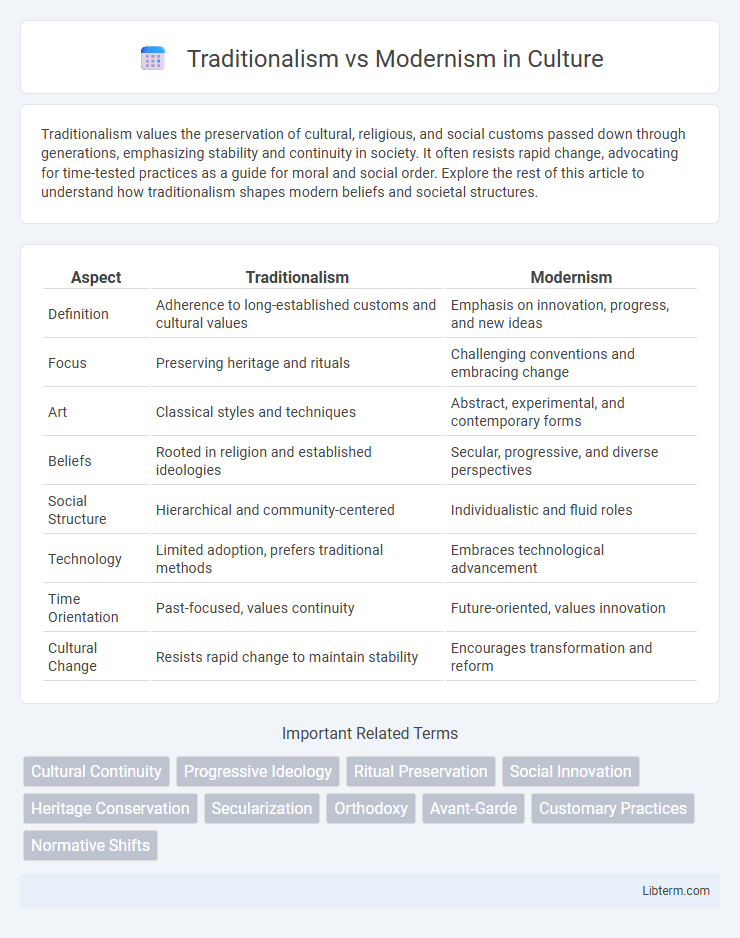Traditionalism values the preservation of cultural, religious, and social customs passed down through generations, emphasizing stability and continuity in society. It often resists rapid change, advocating for time-tested practices as a guide for moral and social order. Explore the rest of this article to understand how traditionalism shapes modern beliefs and societal structures.
Table of Comparison
| Aspect | Traditionalism | Modernism |
|---|---|---|
| Definition | Adherence to long-established customs and cultural values | Emphasis on innovation, progress, and new ideas |
| Focus | Preserving heritage and rituals | Challenging conventions and embracing change |
| Art | Classical styles and techniques | Abstract, experimental, and contemporary forms |
| Beliefs | Rooted in religion and established ideologies | Secular, progressive, and diverse perspectives |
| Social Structure | Hierarchical and community-centered | Individualistic and fluid roles |
| Technology | Limited adoption, prefers traditional methods | Embraces technological advancement |
| Time Orientation | Past-focused, values continuity | Future-oriented, values innovation |
| Cultural Change | Resists rapid change to maintain stability | Encourages transformation and reform |
Defining Traditionalism and Modernism
Traditionalism emphasizes the preservation of established customs, beliefs, and cultural values rooted in historical continuity and social stability. Modernism advocates for innovation, experimentation, and the rejection of conventional norms to embrace progress and new perspectives in art, literature, and society. The tension between Traditionalism and Modernism reflects conflicting priorities between honoring past traditions and pursuing transformative change.
Historical Roots of Traditionalism
Traditionalism traces its origins to early philosophical and religious doctrines emphasizing the preservation of cultural heritage, social norms, and established institutions. Rooted in classical antiquity and reinforced during the Middle Ages, Traditionalism prioritizes continuity and the transmission of inherited wisdom across generations. This historical foundation underpins its resistance to rapid change and its preference for enduring values over novel innovations.
Emergence and Principles of Modernism
Modernism emerged in the late 19th and early 20th centuries as a response to the rigid conventions of Traditionalism, emphasizing innovation, abstraction, and experimentation across art, literature, and architecture. It rejected historical styles, celebrating individual expression, functionalism, and the embrace of new technologies and materials such as steel and concrete. Core principles of Modernism include simplicity, minimalism, and the belief that form follows function, reflecting a break from the ornamental and narrative-driven focus of Traditionalism.
Core Values and Beliefs of Traditionalists
Traditionalists emphasize the preservation of cultural heritage, prioritizing values such as community cohesion, respect for authority, and adherence to established customs and rituals. They believe in maintaining social order through tradition, viewing change with skepticism and often advocating for stability and continuity in moral and social norms. Core beliefs include the importance of family, religious faith, and collective responsibility as foundations for individual identity and societal well-being.
Key Characteristics of Modernist Thought
Modernist thought emphasizes individualism, experimentation, and a break from traditional forms, advocating for innovation in art, literature, and social norms. It values subjective experience, fragmentation, and abstract expression, reflecting rapid industrialization and technological advances of the early 20th century. Modernism often challenges established authority and embraces ambiguity, promoting new perspectives on reality and human consciousness.
Cultural and Social Impacts
Traditionalism emphasizes the preservation of long-established customs, social structures, and cultural heritage, fostering a strong sense of identity and continuity within communities. Modernism challenges these conventions by promoting innovation, individualism, and progressive values, which can lead to social fragmentation but also drive cultural evolution and inclusivity. The tension between Traditionalism and Modernism shapes societal norms, influencing education, family dynamics, and artistic expression across diverse cultures.
Traditionalism vs Modernism in Art and Architecture
Traditionalism in art and architecture emphasizes classical forms, historical styles, and craftsmanship rooted in cultural heritage, often prioritizing symmetry, ornamentation, and natural materials. Modernism rejects historical conventions, favoring abstraction, minimalism, functionalism, and new materials such as steel, glass, and concrete to create innovative, forward-looking designs. This contrast reflects broader cultural tensions between preservation of identity and embracing progress through experimentation and technological advancement.
Education and Knowledge Systems: A Comparative View
Traditionalism in education emphasizes time-honored teaching methods, rote memorization, and classical curricula rooted in cultural heritage, fostering discipline and respect for established knowledge systems. Modernism advocates for student-centered learning, critical thinking, and integration of technology, promoting adaptability and creativity in acquiring knowledge. Comparative studies reveal that blending traditional values with modern educational tools enhances cognitive development and cultural continuity, addressing both historical context and contemporary needs.
Conflicts and Reconciliations Between the Two
Traditionalism emphasizes preservation of long-established customs, values, and social structures, often resisting rapid change advocated by Modernism, which champions innovation, progress, and individual freedom. The conflict arises in areas like art, religion, and politics, where traditional norms clash with modern ideas, leading to cultural and ideological tensions. Reconciliations occur through hybrid approaches that integrate core traditional values with selective modern innovations, fostering dialogue and coexistence between the two perspectives.
The Future: Toward a Balanced Synthesis
The future of cultural evolution leans toward a balanced synthesis between Traditionalism and Modernism, integrating time-honored values with innovative advancements to foster sustainable development. Embracing technological progress while preserving ethical foundations ensures social cohesion and adaptive resilience in an increasingly complex world. This equilibrium supports holistic growth, combining respect for heritage with responsiveness to contemporary challenges.
Traditionalism Infographic

 libterm.com
libterm.com